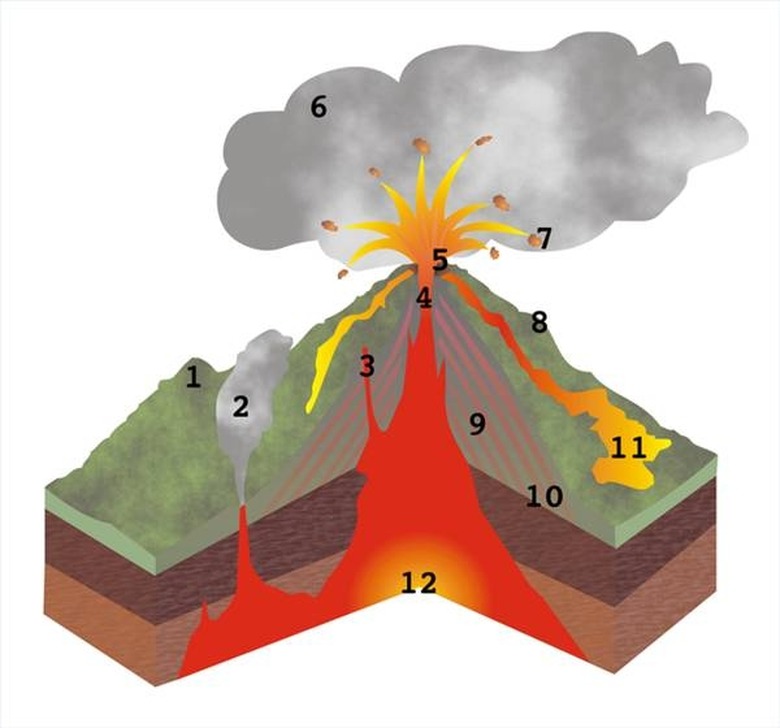How To Make A Realistic Erupting Volcano
Volcanoes are always an interesting natural phenomenon to kids, especially when the volcano is erupting and spewing lava from the top. Making realistic erupting volcanoes is a staple of elementary and high school science fairs. This guide shows how to create a realistic-looking erupting volcano using household supplies. It is a simple project that can be embellished as much as the creators choose.
Step 1
Make the material for the outside of the volcano. The outside of the volcano will be sculpted with a flour mixture, not unlike that of papier-mâché but thicker like a cake batter. Mix the 6 cups of flour, 2 cups of salt, 4 tablespoons of cooking oil and 2 cups of water in a large bowl until the mixture is smooth and firm. Add some food coloring to color the dough as the color of a real volcano — a kind of a dark brown (use some red and blue food coloring). Place the dough on a flat surface coated with flour and roll it out into a large thin sheet with a rolling pin (it should be large enough to cover the soda bottle and the rest of the volcano parts).
Step 2
Assemble the volcano. Cut a sheet of cardboard from a box (about 2 foot square) and lay it on a flat surface. Place the 1-liter soda bottle (with the bottle cap removed) in the center of the sheet of cardboard and attach it with superglue. Roll the old newspaper into large balls and tape or glue them together around the outside of the bubble to form the cone shape of the volcano (make sure they go around the top of the bottle but not blocking the spout of the bottle. Lay the sheet of dough over the bottle and the newspaper balls. Place a hole in the dough over the top of the spout of the bottle. Tease the surface of the wet dough with a metal fork to give it the appearance of the surface of the volcano rock. Allow the dough to dry.
Step 3
Decorate the volcano. Paint the dough with earthy colors for the rocks, dark green for vegetation, and orange, yellow and red around the outside of the top to represent the lava starting to flow out. Be as creative as you want.
Step 4
Make the volcano erupt. Pour 1 tablespoon of dish soap, 1 tablespoon of baking soda, food coloring to make the liquid look like lava (red and yellow) and a few tablespoons of water into the spout of the soda bottle. Prepare the volcano and spectators for the eruption. Pour 1/4 cup of vinegar into the bottle on top of the other ingredients; the chemical reaction between ingredients causes the colored liquid to foam and shoot out through the bottle spout and over the edges of the volcano.
Things Needed
- 6 cups flour
- 2 cups salt
- 4 tablespoons oil
- 2 cups water
- Food coloring (blue, red and yellow)
- Large bowl
- Sheet of cardboard
- 1-liter soda bottle
- Superglue
- Newspaper
- Tape
- Rolling pin
- Metal fork
- 1 tablespoon dish soap
- 1 tablespoon baking soda
- A few tablespoons of water
- 1/4 cup white vinegar
TL;DR (Too Long; Didn't Read)
The outside surface of the volcano may also be created with papier-mâché , clay or foil instead of the flour dough. Be sure to set the volcano off in an open area and not close to anything that you do not want to get sprayed with the baking soda mixture because it sprays far at times.
Cite This Article
MLA
Gugie, John. "How To Make A Realistic Erupting Volcano" sciencing.com, https://www.sciencing.com/realistic-erupting-volcano-4781740/. 24 April 2017.
APA
Gugie, John. (2017, April 24). How To Make A Realistic Erupting Volcano. sciencing.com. Retrieved from https://www.sciencing.com/realistic-erupting-volcano-4781740/
Chicago
Gugie, John. How To Make A Realistic Erupting Volcano last modified August 30, 2022. https://www.sciencing.com/realistic-erupting-volcano-4781740/
